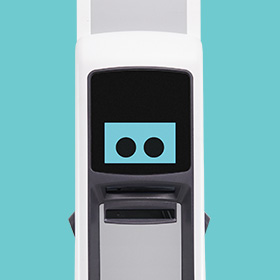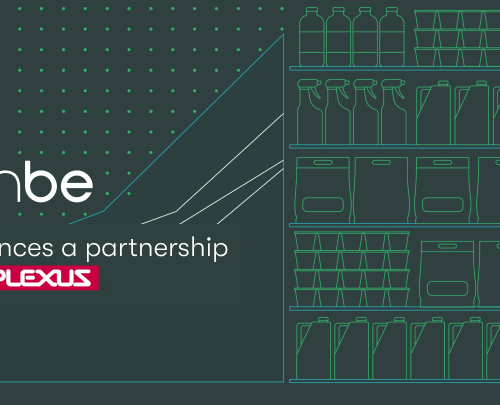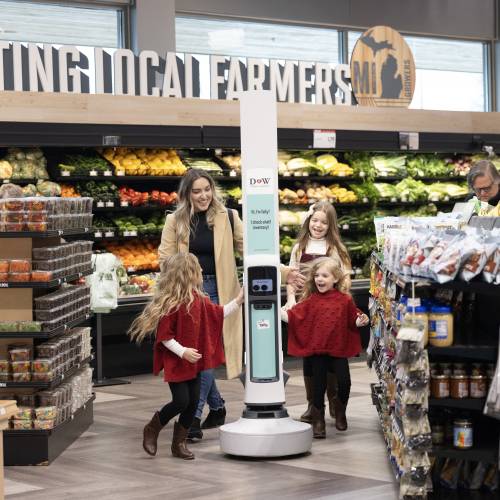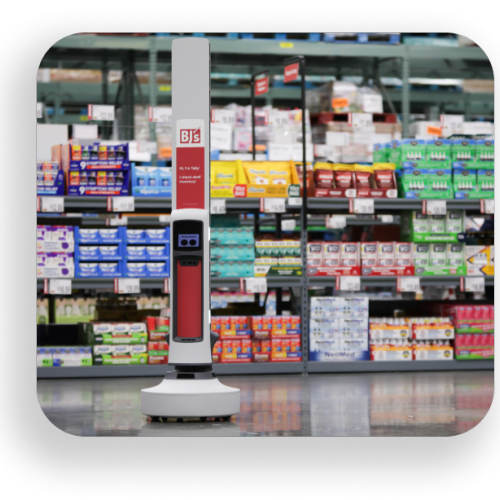Having a precise inventory count of items inside large retail locations like grocery stores and wholesale clubs is difficult in the modern retail landscape. The same is true for maintaining an accurate, real-time view of inventory pricing and promotion accuracy, as well as exact product locations. It’s essentially impossible to get a comprehensive view of inventory with manual audits, which are time-consuming and labor-intensive.
The longer items remain unstocked, the more sales dollars are left on the table – and that doesn’t account for impacts on shopper satisfaction and loyalty. Additionally, incorrect price tags can expose retail businesses to fines for failing to adhere to consumer protection laws. Without precise, real-time and actionable insights into inventory levels and conditions, errors like these can continue to fall through the cracks—leaving both customers and suppliers dissatisfied.
Increasingly, retail leaders are using cameras to serve as that extra set of eyes. But not all cameras are created equal, and there's more than one way to utilize cameras for inventory management in stores—and more than one reason why. Knowing whether to use fixed cameras or autonomous mobile robots (or a combination of the two) can save retailers 5% in operating margin and 4.5% annual revenue through better inventory management.
Read on to learn how these two imaging technologies can be used effectively in stores, either together or on their own. And please don’t miss the comparative chart at the end, which summarizes key product capabilities and investment requirements for fixed cameras and autonomous mobile robots!
What are fixed cameras and autonomous mobile robots?
Both fixed cameras and autonomous mobile robots can serve the same general purpose in stores—monitoring and managing inventory. As the names imply, the main difference between the two types of cameras is whether they move, but other business-critical differences also impact a return on the technical investment.
Fixed Cameras
Fixed cameras are attached to shelves or walls in the store or wholesale club. They are typically drill-mounted and need cables, battery packs, and power outlets to operate. Once attached, they remain in one place and continuously monitor a defined area of the store or wholesale club. They can’t be moved without being remounted or manually repositioned, and fixed shelf cameras generally have inferior ability to capture inventory count, shelf depth, and other critical information like price and promotion accuracy as well as reliable item locations.
Autonomous Mobile Robots
An autonomous mobile robot captures pictures by moving around the store to gather data. The cameras can be integrated in a device like a smartphone or tablet, carried around the store by an associate—or are mounted in a roaming robot like our Tally, which offers market-leading precision thanks to its AI computer vision.
For handheld cameras to work, associates must physically visit every part of the club or store to collect inventory insights. Consistent visual capture with handheld cameras can be very difficult to achieve due to the inconsistent nature of human movement. On the other hand, robots traverse clubs and stores autonomously to gather real-time, precise inventory counts as well as exact information on item location and price tag and promotion accuracy. In general, mobile cameras have a greater ability to capture depth and to move closer or farther away from products to optimize images.
How do fixed shelf cameras and autonomous mobile robots work in retail?
Factors such as store layout, size and type all help determine whether a store needs fixed sehfl cameras versus mobile robots. Each are better suited to different environments and different objectives. For example, fixed shelf cameras might be a good solution for monitoring security, especially at self-checkout counters, thanks to their continuous coverage capabilities. Mobile robots, on the other hand, offer flexibility that is well-suited for dynamic inventory management in larger stores like grocery, warehouse, or wholesale club locations.
The two types of cameras are often better suited to different environments and different objectives. Mobile cameras in robots offer flexibility that is well-suited for dynamic inventory management in larger stores.
Where fixed cameras shine: Continuous monitoring in small retail store footprints
Beyond checkout security, smaller retail locations might also want continual pictures of certain high-traffic areas or high-value shelves.
When used for inventory management, fixed cameras work better in environments with smaller footprints, like convenience stores. While fixed cameras struggle to produce quality images when aisles are wide, as in grocery stores or member clubs, convenience stores’ shorter, narrower aisles make it possible for fixed cameras to capture higher quality images of the opposing shelf.
Retailers should also keep in mind, however, that a fixed camera’s field of view is typically limited in these narrower environments, because they don’t have the autonomous ability to move or change their angle to achieve depth perception. This means retailers may have to invest in a greater number of fixed cameras to capture the same amount of space, leading to potentially higher costs from the get go – and we haven’t talked about the cost of common damage to fixed cameras yet!
Where fixed cameras fall short: large formats and camera quality
Because of their limited range, fixed cameras may result in coverage gaps in larger areas. Smaller store footprints allow retailers to use fewer cameras in total, potentially saving on cost and keeping the store’s technology infrastructure and bandwidth low, which is not the case for grocery stores and wholesale member clubs. Using hundreds of fixed cameras in a larger retail environment can lead to footage lags or negative operational impacts to other technology on the same network.
Not to mention, distracted customers and associates can accidentally knock cameras that are permanently stationed throughout the store. In busy retail environments where items are constantly moved, and shoppers must wade through crowded aisles, fixed cameras can easily get damaged. Maintenance costs can skyrocket fast.
Due to fixed cameras’ risk of damage and lower coverage area, the cameras themselves need to be cheaper—which is another way of describing why they offer lower image quality. It is difficult in larger stores to gather data from product labels or to accurately capture shelf depth, which is essential to having an accurate inventory count. Some fixed camera systems even need items to be precisely lined up at the front of shelves to avoid being incorrectly flagged as out, which then requires associates to use their valuable time adjusting products to be seen by the fixed cameras.
Perhaps most critically: computer vision algorithms struggle to leverage fixed camera’s lower quality data to produce reliable, actionable insights. Intelligence is useless if you don’t know what to do with it!
Computer vision algorithms struggle to leverage fixed camera’s lower quality data to produce reliable, actionable insights. Intelligence is useless if you don’t know what to do with it!
To make matters more complicated, fixed cameras rely on planograms to inform them of what items are being shelved at particular locations, whereas mobile cameras like robots do not. This introduces an additional challenge to collecting meaningful inventory data, since many retailers already struggle to comply with planograms. In stores today, most product categories are less than 50% compliant with approved planograms.
Where robots shine: Inventory management in medium to large stores
For grocery stores and wholesale clubs, autonomous mobile robots are better suited to manage inventory by providing high-quality, real-time information about inventory count, item location, and price and promotion accuracy. While potentially a higher upfront cost, mobile cameras can see more of the store with far fewer cameras than fixed sensors. Robots cameras are also precise and sophisticated enough to read minute details of price tags and measure shelf depth accurately to understand when items are low, not just entirely out. This added visibility can even help warehouses and wholesale clubs gather comprehensive data from their highest steel shelves, more than several feet above a store associate’s direct line of sight.
Plus, autonomous mobile robots can work directly with electronic shelf labels and pick up location data while they move around the store, providing information to drive online inventory accuracy, faster online order fulfillment, more accurate pricing and promotions, and planogram compliance. Mobile cameras also make it easier to use employee time more effectively, focusing more on customer service.
Mobile options also typically have a much lower overall impact on store infrastructure. Tally, for example, only needs to connect to a store’s wifi and designate an area where the robot can charge— that’s it. Our advanced computer vision technology also compresses the images Tally captures so that the data doesn’t strain store networks.
Robots can see more of the store with fewer cameras—which also means that the actual cameras are sophisticated enough to read minute details of price tags and accurately measure shelf depth to understand when items are low, not just entirely out.
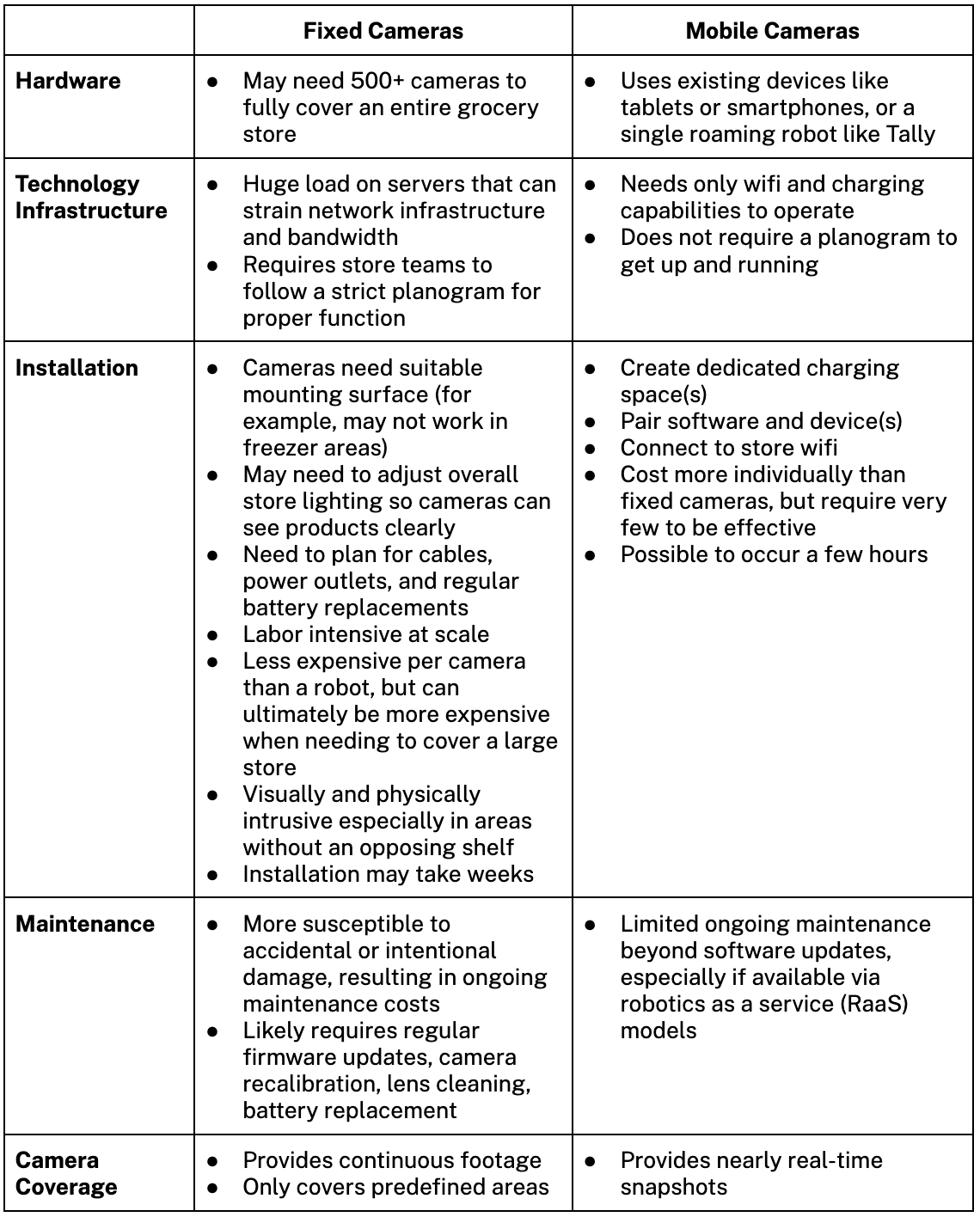
The Bottom Line: Understand the Objective
Ultimately, fixed shelf cameras and autonomous mobile robots offer stores different options in terms of function, cost, installation and maintenance requirements, image quality, and network demands. And the two aren’t mutually exclusive. Some stores choose to use a combination of camera types to gain extra security for valuable items or to combat retail shrink.
The main thing to keep in mind is to use each type of camera for the type of work it is best suited for. When deployed effectively, camera systems can optimize store intelligence, boosting bottom lines while allowing employees to allocate more of their time to serve customers.
To learn about Simbe’s autonomous mobile robot inside Tally, you can schedule a demo here.
